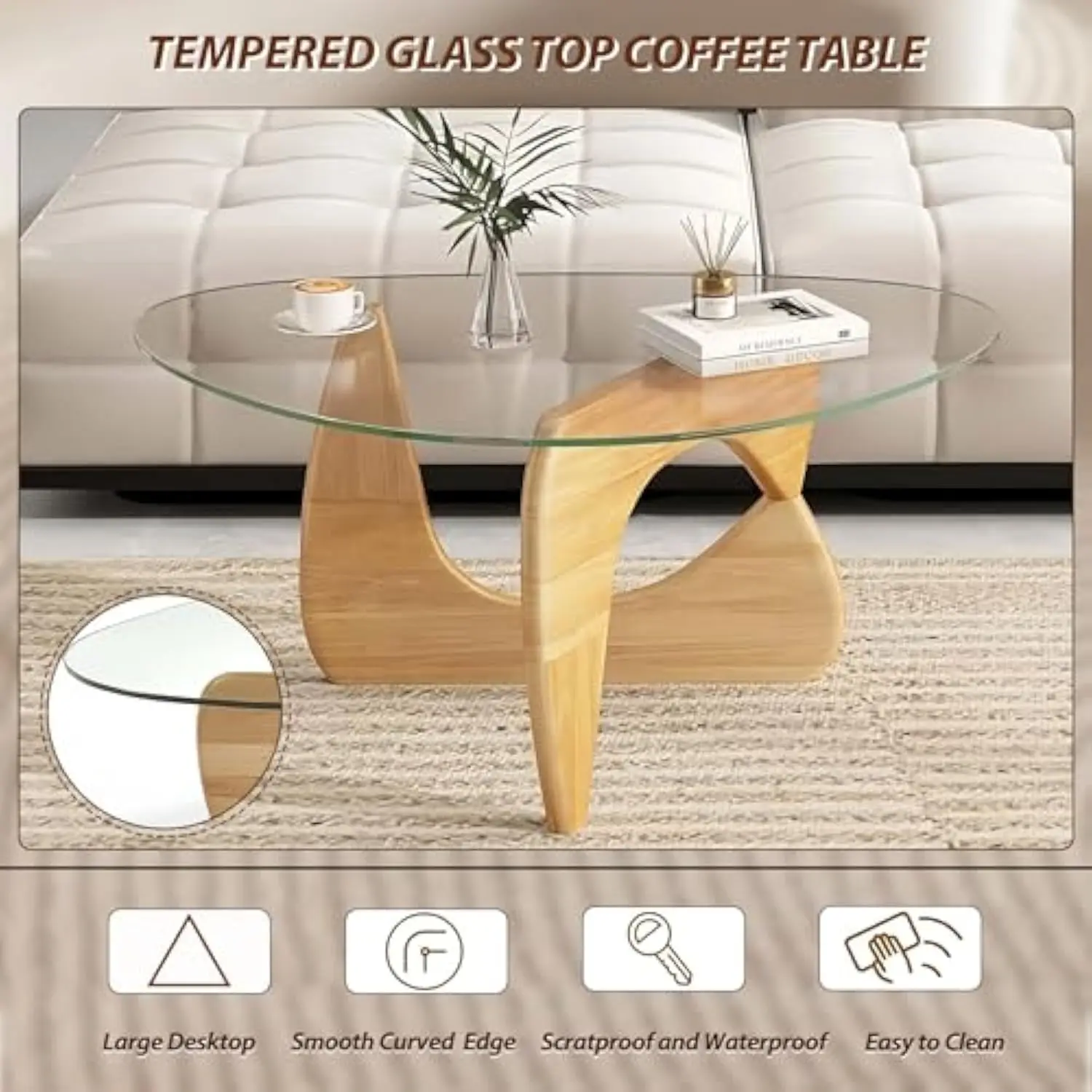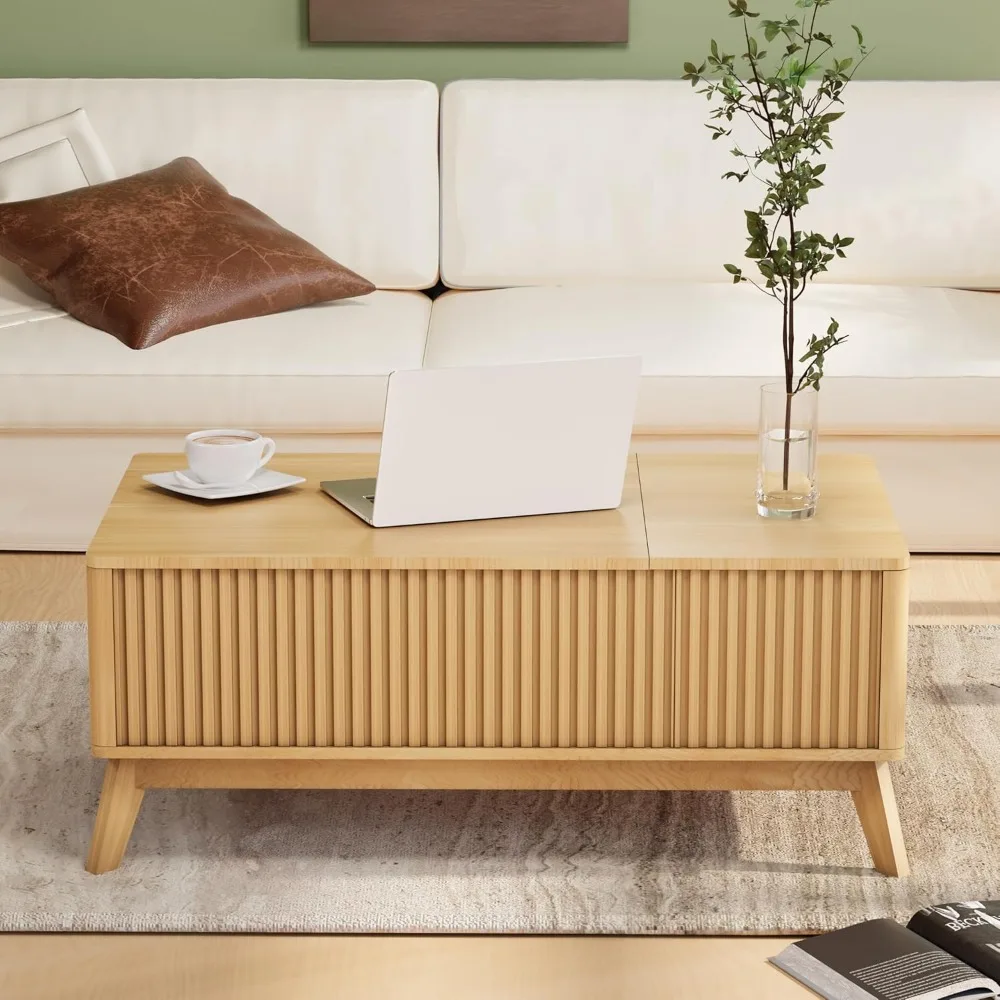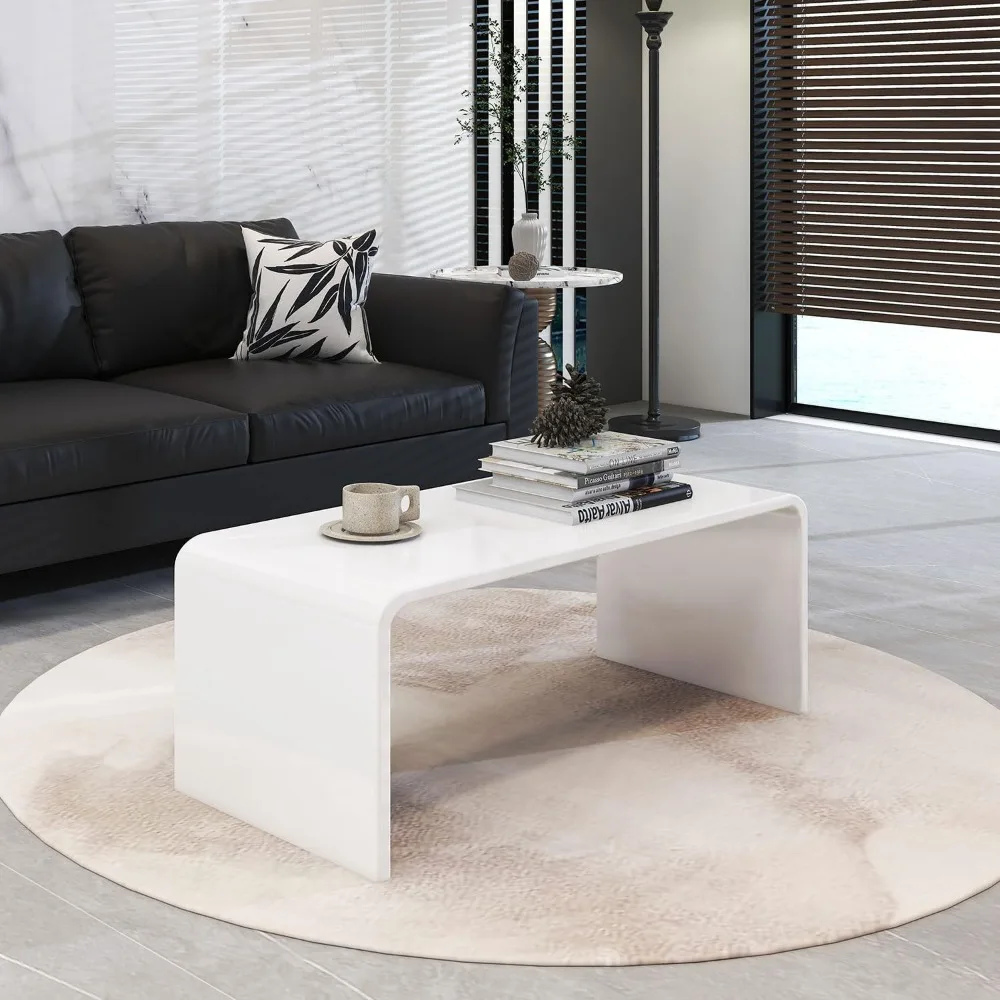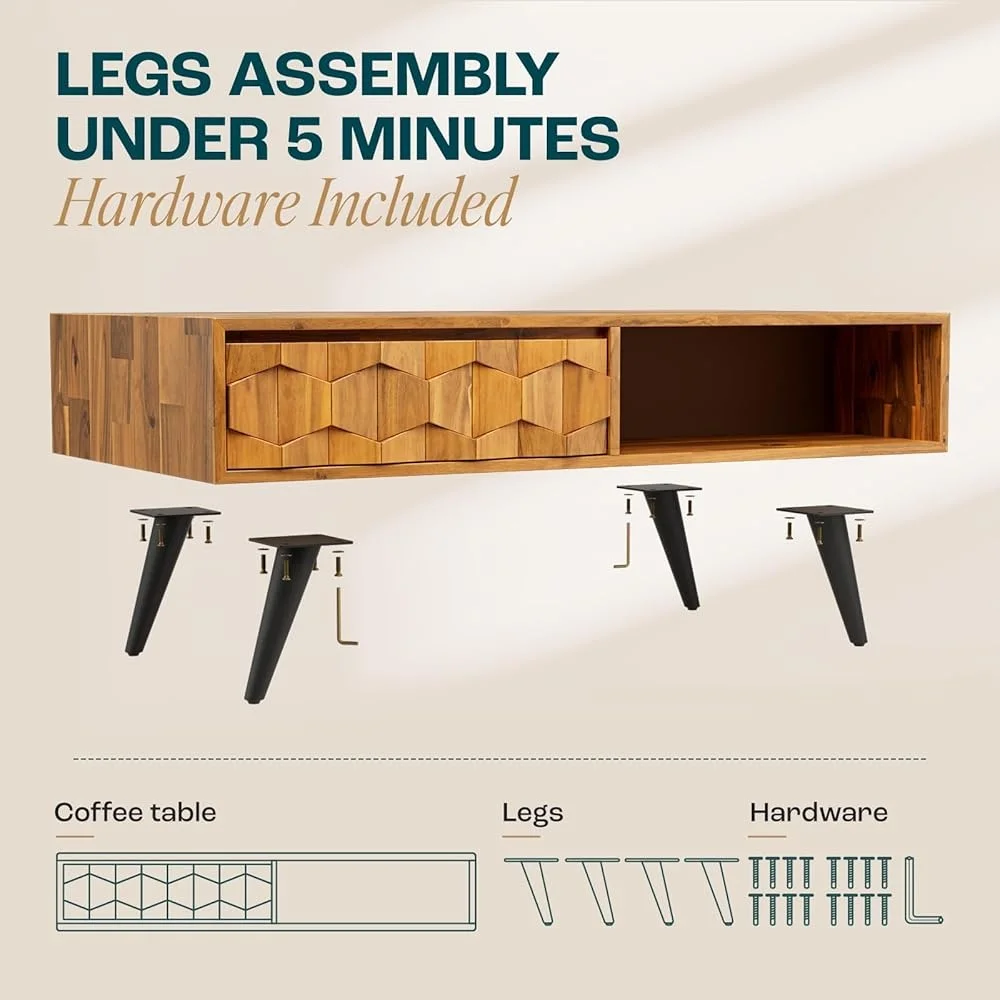Introduction
A rectangular coffee table serves as more than just a piece of furniture – it’s the centerpiece that anchors your entire living space. Whether displaying cherished books, holding evening refreshments, or providing a spot to prop up tired feet, this versatile piece silently defines your room’s character and functionality. Before selecting the perfect rectangular coffee table, understanding its key design traits can make all the difference between a hasty purchase and a thoughtful addition to your home.
The enduring appeal of rectangular coffee tables stems from their perfect blend of form and function. With roots in mid-century modern design philosophy, these tables showcase the beautiful principle that practical objects should also be visually pleasing. Their clean lines, balanced proportions, and adaptable nature have made them a steadfast favorite across generations.
In this guide, we’ll walk you through the essential design characteristics that define exceptional rectangular coffee table design features, helping you make an informed decision that enhances your living space for years to come.
Why Rectangular Coffee Tables Remain a Timeless Choice
The rectangular coffee table has maintained its popularity through decades of changing interior design trends for several compelling reasons. This enduring shape offers natural advantages that make it a practical and aesthetically pleasing choice for most living spaces.
Rectangular coffee tables provide:
- Proportional harmony with standard sofas and sectionals, creating visual balance in your seating arrangement
- Space efficiency in various room layouts, fitting neatly into both large open areas and compact living spaces
- Maximized surface area for functionality, offering ample space for books, beverages, and decorative items
- Zone definition capabilities in open-plan living spaces, helping to visually separate conversational areas
- Natural traffic flow guidance around your living area, creating intuitive pathways for movement
These advantages align perfectly with mid-century modern design principles that emphasize both beauty and utility. The rectangular shape serves dual purposes – it’s visually appealing while providing practical functionality. Ideally, a rectangular coffee table should measure about two-thirds the length of your sofa, creating balanced proportions that feel natural and intentional.
Understanding the fundamental differences between rectangular vs square coffee tables can help you determine which shape better suits your specific space and needs.
Critical Design Elements: Proportion and Scale
The foundation of any well-designed rectangular coffee table lies in its proportions and scale. Getting these elements right ensures your table looks appropriate in your space and functions effectively with surrounding furniture.
Golden Rules for Sizing
- Length: Aim for approximately 2/3 the length of your sofa for visual balance
- Height: Align within 1-2 inches of your sofa seat height, typically 16-18 inches (40-45 cm)
- Width: Should allow comfortable movement while maintaining visual proportion to room size
- Clearance: Maintain 12-18 inches (30-45 cm) between table edge and seating for easy movement
In smaller spaces, you might need to adjust these proportions slightly. A table that’s too large will make the room feel cramped, while one that’s too small may appear insignificant and less functional. Consider how transforming room layout with rectangular coffee tables can optimize your living space.
Visual weight also impacts perceived scale. A glass-topped table with slim legs appears lighter and less imposing than a solid wood piece with block legs, even when their actual dimensions are identical. This becomes especially important in compact living areas where maintaining an open feel is essential.
For open concept spaces, rectangular tables excel at defining conversation areas while maintaining flow between zones. Their linear form creates natural boundaries without the abruptness of square tables or the space inefficiency of round ones.
Our mid-century modern rectangular coffee tables collection showcases pieces designed with these critical proportional elements in mind.
Material Selection: Defining Character and Longevity
The materials used in a rectangular coffee table fundamentally shape its visual appeal, durability, and maintenance needs. Each material brings its own distinct characteristics to your living space.
Wood
Solid Hardwoods (Oak, Walnut, Maple, Cherry)
* Visual characteristics: Warm, natural grain patterns; rich color that deepens over time
* Durability: Excellent longevity with proper care; resistant to dents and scratches
* Maintenance: Regular dusting; occasional polishing; avoid direct sunlight and moisture
* Style alignment: Mid-century modern, traditional, rustic, Scandinavian
Engineered Wood and Veneers
* Visual characteristics: Consistent appearance; wide range of finishes available
* Durability: Moderately durable; can be susceptible to water damage
* Maintenance: Gentle cleaning; avoid harsh chemicals and excess moisture
* Style alignment: Contemporary, modern, transitional
Reclaimed Wood
* Visual characteristics: Distinctive character with marks, nail holes, and varied coloration
* Durability: Generally sturdy with unique aged character
* Maintenance: Similar to solid wood but may require special care for original finishes
* Style alignment: Rustic, industrial, eclectic, bohemian
Glass
Tempered Glass (Clear, Frosted, Smoked)
* Visual characteristics: Creates visual lightness; reveals lower structure; reflects light
* Durability: Impact-resistant but can still shatter; shows fingerprints and dust
* Maintenance: Regular cleaning with glass-specific products to prevent streaking
* Style alignment: Modern, contemporary, minimalist, transitional
Metal
Steel, Iron, Aluminum, Brass
* Visual characteristics: Clean lines; industrial appeal; various finishes from matte to high polish
* Durability: Exceptionally strong; may show scratches depending on finish
* Maintenance: Simple dusting; occasional polishing for shinier finishes
* Style alignment: Industrial, modern, contemporary, mid-century
Stone
Marble, Granite, Concrete, Travertine
* Visual characteristics: Natural patterns; substantial presence; luxurious appearance
* Durability: Extremely hard but can chip; porous stones may stain
* Maintenance: Regular sealing; immediate cleanup of spills; specific cleaners
* Style alignment: Luxury, contemporary, traditional, minimalist
Mid-century modern design particularly favors natural hardwoods with warm tones and organic shapes. The emphasis on quality materials that show their natural beauty aligns perfectly with this design philosophy. Our mid-century modern glass top coffee tables showcase how transparent surfaces can be combined with wood or metal for striking visual effect.

Base Design: The Architectural Foundation
The base and leg design of a rectangular coffee table forms its architectural foundation, dramatically influencing its overall aesthetic appeal. This often-overlooked element can completely transform the table’s character.
Common Leg Styles
Tapered Legs
* Signature mid-century modern feature
* Wider at top, narrowing toward floor
* Creates sense of lightness and elegance
Straight/Block Legs
* Clean, minimalist appearance
* Substantial presence and stability
* Works well in contemporary and traditional settings
Hairpin Legs
* Thin metal legs with distinctive bend
* Industrial-meets-mid-century aesthetic
* Creates visual space beneath table
X-Frame Designs
* Distinctive crossed supports
* Architectural interest and stability
* Often seen in transitional or contemporary styles
Sled Bases
* Continuous metal or wood base
* Modern, streamlined appearance
* Excellent stability on various flooring types
Pedestal Supports
* Central support rather than corner legs
* Makes a strong design statement
* Can provide maximum legroom
The placement of legs affects not only stability but also the table’s visual weight and how it interacts with surrounding furniture. Corner-positioned legs create a traditional, defined boundary, while inset legs create a floating appearance that feels more contemporary.
Base construction types range from open frame designs that create visual lightness to solid or plinth bases that provide substantial presence. The complete guide to rectangular coffee table design explores these variations in greater detail.
For authentic mid-century charm, explore our collection of mid-century modern solid wood coffee tables featuring distinctive base designs that honor this timeless aesthetic.
Storage and Functionality Features
While surface area serves as the primary function of any coffee table, many rectangular designs incorporate additional features that enhance their versatility and practicality in everyday life.
Common storage and functional elements include:
- Open shelves for displaying books, magazines, and decorative objects while keeping them easily accessible
- Drawers for concealing remote controls, gaming controllers, and other small items that might otherwise create visual clutter
- Lift-top mechanisms that raise a portion of the surface to comfortable working height for laptops or dining
- Hidden compartments beneath the surface for storing items out of sight while keeping them accessible
- Nesting capabilities where smaller tables tuck under the main piece, providing extra surfaces when needed
These functional elements embody the mid-century modern principle that “form follows function” – the idea that an object’s design should primarily relate to its intended purpose. The best designs integrate these features seamlessly without compromising aesthetic appeal.
When evaluating functionality, consider your typical activities in the space. Do you regularly work from your coffee table? Do you need storage for throws or board games? Do you entertain frequently? These lifestyle questions will guide which functional features will serve you best.

Our mid-century modern lift-top coffee tables combine classic design with practical functionality for modern living needs.
Mid-Century Modern Solid Wood Coffee Tables, Mid-Century Modern Teak Coffee Tables
$879.95 Select options This product has multiple variants. The options may be chosen on the product pageMid-Century Modern Danish Coffee Tables, Mid-Century Modern Oval Coffee Tables, Mid-Century Modern Solid Wood Coffee Tables
$390.05 Select options This product has multiple variants. The options may be chosen on the product pageMid-Century Modern Coffee & End Table Sets, Mid-Century Modern Coffee Table Sets, Mid-Century Modern Oval Coffee Tables
Price range: $257.48 through $331.04 Select options This product has multiple variants. The options may be chosen on the product pageMid-Century Modern Glass Top Coffee Tables, Mid-Century Modern Glass Top Side & End Tables
$460.58 Select options This product has multiple variants. The options may be chosen on the product pageMid-Century Modern Glass Top Coffee Tables, Mid-Century Modern Vintage Coffee Tables, Mid-Century Modern Vintage Side & End Tables
$725.36 Select options This product has multiple variants. The options may be chosen on the product pageMid-Century Modern Lift Top Coffee Tables, Mid-Century Modern Square Coffee Tables
$454.73 Select options This product has multiple variants. The options may be chosen on the product page
Finding Your Style: Matching Tables to Interior Design Aesthetics
Rectangular coffee tables adapt remarkably well to different interior design aesthetics, making them versatile choices for virtually any home style. Understanding the defining characteristics of each style helps you select a table that complements your existing decor.
Mid-Century Modern
* Tapered legs with outward angle
* Clean, organic shapes with minimal ornamentation
* Natural woods like walnut, teak, and oak
* Emphasis on function with elegant simplicity
Minimalist
* Streamlined silhouettes with little embellishment
* Neutral colors or monochromatic schemes
* Often features glass or light-toned woods
* Focus on essential elements only
Industrial
* Raw materials like distressed wood and metal
* Visible hardware and mechanical elements
* Rugged construction with emphasis on utility
* Often incorporates recycled or repurposed elements
Rustic/Farmhouse
* Weathered or distressed finishes
* Substantial proportions with sturdy construction
* Natural wood with visible grain and knots
* Simple, traditional forms with practical function
Traditional
* Rich wood tones with decorative detailing
* Classic proportions and symmetry
* Often features carved elements or turned legs
* Formal appearance with refined finishes
Scandinavian
* Light-colored woods like ash, birch, or maple
* Simple forms with subtle organic influences
* Functional design with clean lines
* Often features natural materials and textures
Contemporary
* Mixed materials like glass with metal or wood
* Innovative shapes and asymmetrical elements
* Current trends rather than historical references
* Often incorporates bold colors or high contrast
The design elements of marble mid-century tables show how natural stone can be incorporated into this beloved style, while our guide on styling secrets for rectangular mid-century tables offers practical advice for enhancing these pieces in your home.
Essential Practical Considerations Before Purchase
Beyond aesthetics, several practical factors deserve careful consideration before selecting your rectangular coffee table:
Construction Quality Assessment
* Look for solid joinery techniques like dovetail or mortise-and-tenon
* Check for sturdy, wobble-free construction
* Examine finish quality, especially on edges and underside
* Verify weight capacity matches your intended use
Stability Testing
* Table should feel solid and not tip when pressure is applied to edges
* Base should provide adequate support across the entire surface
* Consider top-heavy designs carefully, especially with children present
Edge and Corner Considerations
* Rounded or beveled edges are safer in homes with young children
* Sharp corners may pose risks but offer a more defined, architectural look
* Edge detail affects both safety and visual style
Surface Durability
* Consider heat resistance if hot drinks will be placed directly on surface
* Evaluate scratch resistance based on expected use
* Assess water resistance for households where spills are likely
Cleaning Requirements
* Some materials require specific cleaning products or techniques
* High-maintenance finishes may not be practical for everyday use
* Glass shows fingerprints and dust more readily than other materials
Weight Considerations
* Heavier tables offer stability but are difficult to reposition
* Consider if you’ll need to move the table frequently for cleaning or events
* Very light tables may shift during use
Our collection of mid-century modern walnut coffee tables features pieces constructed with these practical considerations in mind, ensuring both beauty and longevity.
Decision Framework: Selecting Your Ideal Table
With so many factors to consider, a structured approach helps simplify your decision process:
Assess Your Lifestyle Needs
* How will the table be used daily? (Display, storage, work surface, dining)
* Who uses the space? (Adults, children, pets)
* How frequently will the table be used?Prioritize Essential Features
* Rank your must-have elements (material, storage, size, style)
* Separate nice-to-have features from essentials
* Consider which elements you’re willing to compromise onBalance Aesthetics with Practicality
* Will the beautiful marble withstand your household’s activities?
* Does the glass surface match your maintenance willingness?
* Is the wooden table durable enough for your needs?Set Realistic Budget Expectations
* Quality materials and construction generally command higher prices
* Consider longevity and cost-per-year of ownership
* Determine where to invest and where to economizeMeasure Your Space Accurately
* Record precise dimensions of your room and seating arrangement
* Create a paper template to test size and placement
* Consider traffic flow around the proposed table location
Understanding space planning with long rectangular tables can help you visualize how your chosen piece will function in your specific room configuration.
Styling Your Rectangular Coffee Table: Maximizing Visual Impact
Once you’ve selected the perfect rectangular coffee table, styling it effectively enhances both its beauty and functionality:
Creating Balanced Arrangements
* Use the rule of three – group objects in odd numbers for visual interest
* Incorporate varying heights to create dynamic dimension
* Mix textures to add tactile interest (smooth ceramics with rough books)
* Use trays to corral smaller items into organized groupings
Practical Styling Tips
* Leave at least 1/3 of the surface empty for actual use
* Consider your sightlines when seated – avoid tall centerpieces that block conversation
* Rotate decorative elements seasonally to refresh your space
* Balance decorative items with functional pieces
For High-Use Tables
* Use coasters and placemats to protect the surface
* Select decorative items that are easy to move when needed
* Consider a smaller arrangement that leaves ample open surface area
* Use stackable books or boxes that can be easily reorganized
The principles of styling rectangular coffee tables can help you create arrangements that are both beautiful and practical for everyday living.

Is a Rectangular Coffee Table Right for Your Space?
Q: Are rectangular coffee tables suitable for small spaces?
A: Yes, when properly sized. In compact rooms, choose narrower rectangular tables that provide functional surface area while maintaining clear pathways around the furniture.
Q: How do rectangular tables work with sectional sofas?
A: Rectangular tables pair beautifully with L-shaped sectionals, providing balanced proportions and accessible surface area for all seating positions.
Q: When might another shape be more appropriate?
A: Round or oval tables may work better in tight spaces, with young children (no sharp corners), or when your primary furniture arrangement is circular rather than linear.
Q: Can rectangular tables work in irregular room shapes?
A: Absolutely. Their defined shape can actually help bring order to asymmetrical spaces by creating a visual anchor point.
For specific comparisons, explore the differences between oval vs rectangular coffee tables and round vs rectangle coffee tables to determine which shape best suits your unique space.
How to Care for Different Coffee Table Materials
Wood Care
* Dust regularly with a soft, dry cloth
* Clean spills immediately to prevent staining or water rings
* Use coasters under beverages and hot items
* Apply furniture polish or oil as recommended by the manufacturer
* Position away from direct sunlight and heating vents
Glass Care
* Use glass cleaner or a vinegar-water solution with a lint-free cloth
* Avoid abrasive cleaners that might scratch the surface
* Clean fingerprints and smudges regularly
* Use soft felt pads under objects to prevent scratches
Metal Components
* Dust regularly and wipe with a slightly damp cloth
* Address fingerprints on high-polish surfaces promptly
* Apply metal polish appropriate for the specific finish
* Protect from moisture to prevent rust or tarnish
Stone Surfaces
* Seal according to manufacturer recommendations
* Clean with stone-specific products (avoid acidic cleaners)
* Blot spills immediately, especially acidic liquids like wine or citrus
* Use coasters and trivets to protect the surface
Proper maintenance ensures your selection from our mid-century modern coffee tables collection will remain beautiful for years to come.
Conclusion
The rectangular coffee table remains an enduring favorite for good reason – its versatile shape, functional surface area, and adaptable design make it a cornerstone piece in countless living spaces. By understanding the key design traits – from proportion and materials to base design and functionality – you can select a table that perfectly balances form and function.
Whether you’re drawn to the clean lines of mid-century modern design, the warmth of traditional styles, or the bold statement of contemporary pieces, the right rectangular coffee table can transform your living space. By considering both aesthetic preferences and practical needs, you’ll find a piece that serves you beautifully for years to come.
Remember that a truly excellent coffee table does more than fill space – it enhances your daily living experience while expressing your personal style. With this guide in hand, you’re well-equipped to make an informed choice that brings lasting satisfaction to your home.







